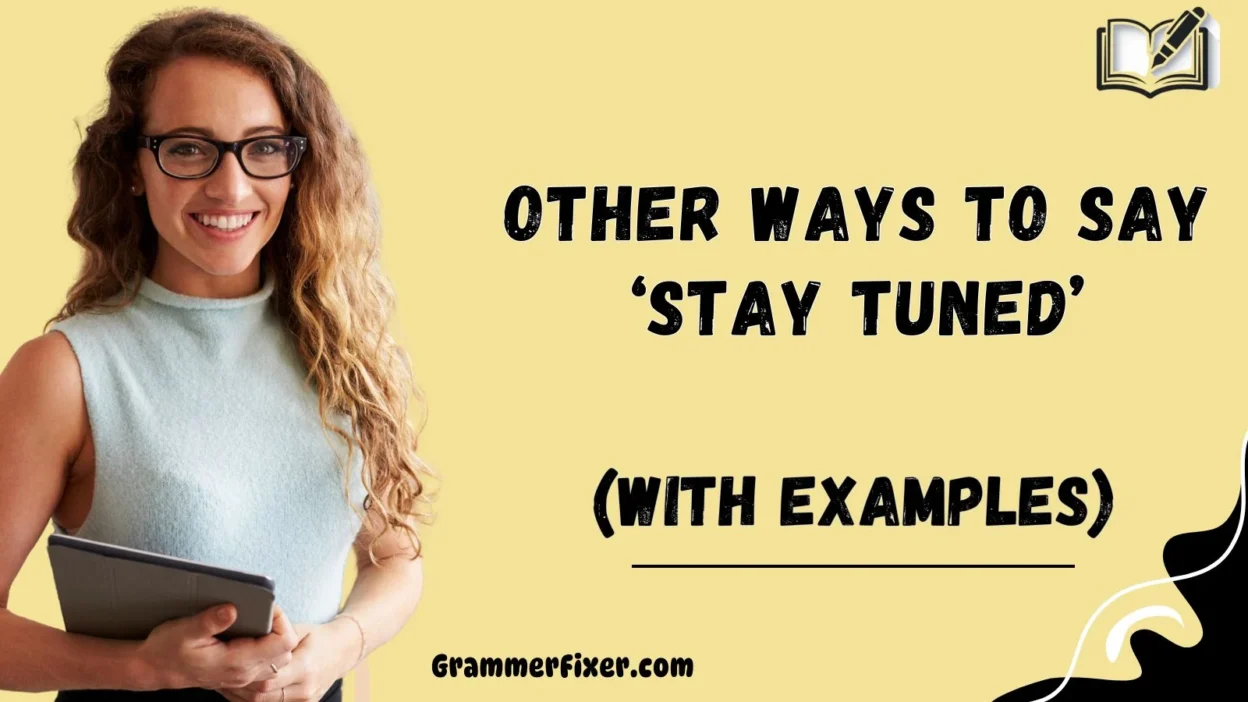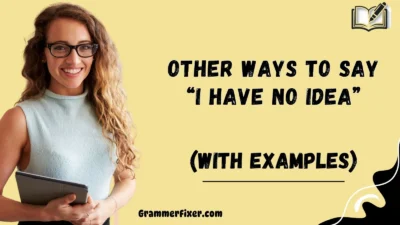Finding the right words to connect with your audience can make even the simplest message feel more personal and meaningful. The phrase “stay tuned” has long been used in communication, but it can sometimes feel overused or flat. If you want your messages to feel more engaging, creative, and aligned with your audience’s needs, exploring alternative expressions can help you communicate warmth, clarity, and excitement in fresh ways.
Below, we’ll explore 30 thoughtful alternatives to “stay tuned,” along with their meanings, best uses, and tone, so you can tailor your communication to fit both professional and personal settings.
What Does “Stay Tuned” Mean?
The phrase “stay tuned” originated from radio and television broadcasts, where presenters would encourage listeners and viewers to remain attentive for the next program or announcement. Today, it’s used across emails, blogs, newsletters, social media, and personal messages to signal that more updates, news, or developments are coming.
When to Use “Stay Tuned”?
You can use “stay tuned” in contexts where you want to:
- Maintain audience interest in upcoming content
- Encourage readers, listeners, or viewers to remain engaged
- Signal that more information or details will be shared shortly
- Add a teasing, suspenseful, or anticipatory tone to your communication
Is It Professional/Polite to Say “Stay Tuned”?
Yes, “stay tuned” is generally considered professional, polite, and universally understood. However, in more formal, international, or corporate communications, some may find it slightly casual or vague. Choosing a synonym or alternative expression can help you match the right tone, professionalism, and clarity for your audience.
Pros or Cons of Saying “Stay Tuned”
Pros:
- Creates anticipation and excitement
- Universally recognized and understood
- Works across multiple platforms (social media, email, newsletters, etc.)
Cons:
- Can feel overused and uninspired
- Lacks specificity in professional settings
- May sound informal in certain cultural or business contexts
1. Keep an Eye Out
Meaning: Encourages someone to remain attentive and observant.
Detailed Explanation: This phrase implies a watchful awareness of something specific and imminent, making it feel more personal and direct.
Scenario Example:
“Keep an eye out for our upcoming July 3, 2024 product launch—it’s going to be a game-changer!”
Best Use: Marketing promotions, exciting announcements, or exclusive sneak peeks.
Worst Use: Highly formal or legal communications, where the tone needs to remain precise and professional.
Tone: Friendly, engaging, anticipatory.
2. Don’t Go Anywhere
Meaning: A casual and playful way to ask the audience to remain attentive.
Detailed Explanation: Originally popular in live broadcasts and television, this phrase adds energy and urgency while keeping the audience connected.
Scenario Example:
“Don’t go anywhere—more exciting updates are coming right after this message.”
Best Use: Informal contexts, podcasts, live events, or playful brand messaging.
Worst Use: Corporate emails or academic settings, where such casual language could sound unprofessional.
Tone: Casual, lively, fun.
3. Watch This Space
Meaning: Suggests that something important will appear soon in a specific place.
Detailed Explanation: Often used in advertising and announcements, it signals that audiences should return frequently to get the latest news.
Scenario Example:
“Watch this space for exclusive insights from our tech conference next month.”
Best Use: Websites, blogs, newsletters, or campaign teasers.
Worst Use: One-to-one communication with a client or executive, where a clearer, more direct phrase would be better.
Tone: Professional yet intriguing.
4. We’ll Keep You Posted
Meaning: Promises to provide updates as soon as they are available.
Detailed Explanation: This phrase is reassuring and straightforward, emphasizing a commitment to clear communication.
Scenario Example:
“We’ll keep you posted on any changes to the event schedule.”
Best Use: Professional emails, project updates, internal communications.
Worst Use: Creative promotional content, where the phrase may sound too plain or uninspired.
Tone: Respectful, polite, professional.
5. Hold Tight
Meaning: Encourages patience and readiness for upcoming news.
Detailed Explanation: Adds a sense of suspense and excitement, while still keeping the message friendly and informal.
Scenario Example:
“Hold tight—we’re about to reveal something amazing!”
Best Use: Announcements, social media, promotional campaigns.
Worst Use: Formal business letters or serious reports, where casual language isn’t appropriate.
Tone: Playful, energetic, suspenseful.
6. Stay Updated
Meaning: A direct and professional way to encourage ongoing awareness.
Detailed Explanation: Emphasizes the importance of remaining informed and works well in both formal and casual settings.
Scenario Example:
“Sign up for our newsletter to stay updated on upcoming events and initiatives.”
Best Use: Professional contexts like emails, newsletters, and websites.
Worst Use: Friendly personal chats, where it may sound too corporate or impersonal.
Tone: Clear, professional, straightforward.
7. Stay Posted
Meaning: Suggests that someone will receive continuous updates.
Detailed Explanation: Similar to “stay updated,” but slightly less formal, often used in conversational or team settings.
Scenario Example:
“Make sure to check Slack daily to stay posted on project changes.”
Best Use: Internal team updates, casual email communication.
Worst Use: Formal reports or communications to high-level stakeholders.
Tone: Friendly, conversational, clear.
8. Stay Informed
Meaning: Encourages people to remain aware of developments.
Detailed Explanation: This is a professional and respectful phrase often used in newsletters, academic, or corporate communications.
Scenario Example:
“Subscribe to our mailing list to stay informed about industry updates.”
Best Use: Formal communications, newsletters, compliance updates.
Worst Use: Social media posts, where it may sound too stiff or academic.
Tone: Formal, clear, professional.
9. Stay Connected
Meaning: Highlights the value of maintaining a link or relationship.
Detailed Explanation: Often used in community-building or relationship-focused messaging, this phrase emphasizes belonging and ongoing engagement.
Scenario Example:
“Join our LinkedIn group to stay connected with like-minded professionals.”
Best Use: Networking, community outreach, membership programs.
Worst Use: Strictly transactional updates like deadlines or regulations, where connection isn’t the main message.
Tone: Warm, relational, inclusive.
10. Be on the Lookout
Meaning: Advises vigilance and attentiveness for something soon to come.
Detailed Explanation: Often used in marketing, safety, or awareness campaigns, this phrase conveys alertness.
Scenario Example:
“Be on the lookout for our next email—it includes exclusive discount codes!”
Best Use: Promotions, marketing teasers, or safety reminders.
Worst Use: Formal legal documents or corporate announcements, where the wording could feel too casual.
Tone: Alert, watchful, anticipatory.
11. More to Come
Meaning: Suggests that additional information or updates are on the way.
Detailed Explanation: Short, clear, and teasing, this phrase builds anticipation without giving too much away.
Scenario Example:
“This is just the beginning—more to come in next month’s update.”
Best Use: Blog posts, newsletters, casual brand updates.
Worst Use: High-stakes professional settings (e.g., compliance announcements) where clarity is essential.
Tone: Teasing, friendly, engaging.
12. Stay Alert
Meaning: Encourages attentiveness and readiness for upcoming information.
Detailed Explanation: Carries a sense of urgency and is often associated with safety or immediate updates.
Scenario Example:
“Stay alert for details on how today’s changes might impact your account.”
Best Use: Urgent updates, security communications, real-time alerts.
Worst Use: Lighthearted or playful contexts like social media promotions.
Tone: Serious, urgent, directive.
13. Stay with Us
Meaning: Requests the audience to remain engaged or present.
Detailed Explanation: Common in live broadcasts or events, it reassures people that the experience is ongoing.
Scenario Example:
“Stay with us—we’ve got a surprise guest joining shortly!”
Best Use: Live streams, webinars, TV/radio, events.
Worst Use: Professional corporate emails, where it could sound overly casual.
Tone: Warm, friendly, inviting.
14. Await Further Updates
Meaning: Tells someone to expect more information later.
Detailed Explanation: A formal, straightforward expression used in professional contexts.
Scenario Example:
“Please await further updates regarding the compliance changes effective March 5.”
Best Use: Corporate, academic, or legal communications.
Worst Use: Informal chats, social media captions, or casual newsletters.
Tone: Formal, serious, precise.
15. Stay Curious
Meaning: Encourages engagement through curiosity and anticipation.
Detailed Explanation: Adds a playful, intellectual touch, inspiring people to remain eager for more insights.
Scenario Example:
“Stay curious—we’ll reveal the answers in tomorrow’s blog post.”
Best Use: Educational content, blogs, creative industries.
Worst Use: Regulatory or corporate memos, where curiosity isn’t the right tone.
Tone: Creative, inspiring, playful.
16. Keep Watching
Meaning: A direct request to continue viewing.
Detailed Explanation: Common in video content, live broadcasts, or webinars, this phrase keeps the audience tuned in until the next part unfolds.
Scenario Example:
“Keep watching to see the behind-the-scenes footage from our latest project.”
Best Use: Video platforms, streaming events, social media stories.
Worst Use: Written corporate communications like emails or reports.
Tone: Direct, casual, engaging.
17. Stay Right Here
Meaning: A warm and casual way to encourage someone not to leave or disengage.
Detailed Explanation: Often used in spoken or informal communication, this phrase conveys closeness and continuity.
Scenario Example:
“Stay right here—the best part of the episode is about to start!”
Best Use: Podcasts, live broadcasts, or informal digital content.
Worst Use: Professional updates, client-facing formal settings.
Tone: Friendly, personal, conversational.
18. Updates Coming Soon
Meaning: Announces that new information will be shared shortly.
Detailed Explanation: Clear and straightforward, this phrase helps set expectations without overhyping.
Scenario Example:
“Updates coming soon—our team is finalizing the details now.”
Best Use: Professional communications, newsletters, corporate project updates.
Worst Use: Overused in marketing teasers, where it might sound bland.
Tone: Professional, polite, reassuring.
19. Stick Around
Meaning: Invites someone to remain present for what’s next.
Detailed Explanation: Playful and colloquial, this phrase is commonly used in media and entertainment contexts.
Scenario Example:
“Stick around—we have an exclusive sneak peek coming your way.”
Best Use: Informal messaging, video content, brand promotions.
Worst Use: Legal documents, compliance updates, or academic memos.
Tone: Casual, upbeat, fun.
20. Stay Close
Meaning: Encourages maintaining attention or proximity to upcoming information.
Detailed Explanation: Carries a warm, relational undertone, making it feel more personal than “stay tuned.”
Scenario Example:
“Stay close—we’ll share the winners of the competition shortly.”
Best Use: Community events, team messaging, friendly brand communication.
Worst Use: Formal or technical communications, where warmth may seem unprofessional.
Tone: Personal, warm, approachable.
21. We’ll Keep You in the Loop
Meaning: Assures the recipient that they won’t miss important updates.
Detailed Explanation: A reassuring phrase often used in professional and collaborative settings, emphasizing inclusion.
Scenario Example:
“Don’t worry—we’ll keep you in the loop as the project develops.”
Best Use: Teamwork, client updates, stakeholder communication.
Worst Use: Marketing campaigns, where it might sound too internal or casual.
Tone: Professional, inclusive, friendly.
22. Await the Details
Meaning: Signals that more specifics will be shared later.
Detailed Explanation: A formal, concise phrase suited for structured updates or official messaging.
Scenario Example:
“Please await the details of the upcoming policy changes.”
Best Use: Corporate announcements, academic updates, legal contexts.
Worst Use: Playful or informal communication (e.g., casual social media).
Tone: Formal, precise, respectful.
23. Stay Patient
Meaning: Encourages patience while waiting for updates or outcomes.
Detailed Explanation: This phrase reassures the audience that progress is happening, even if updates are not immediate.
Scenario Example:
“Stay patient—our team is working hard to deliver results soon.”
Best Use: Project updates, client communication, product launches.
Worst Use: Fast-paced promotional content, where urgency is expected.
Tone: Reassuring, empathetic, calming.
24. Expect More Soon
Meaning: Promises that additional updates or developments are imminent.
Detailed Explanation: Creates a forward-looking and optimistic tone, keeping interest alive.
Scenario Example:
“Expect more soon—we’re just getting started with our sustainability initiatives.”
Best Use: Newsletters, company blogs, marketing updates.
Worst Use: Serious compliance or regulatory announcements.
Tone: Optimistic, anticipatory, engaging.
25. Stay Tuned In
Meaning: A slightly varied version of “stay tuned,” emphasizing active engagement.
Detailed Explanation: Sounds a little more modern and energetic, making it feel refreshed.
Scenario Example:
“Stay tuned in to our live stream for a special guest appearance.”
Best Use: Live broadcasts, podcasts, interactive sessions.
Worst Use: Legal or formal corporate writing.
Tone: Energetic, casual, inviting.
26. Stay Ready
Meaning: Encourages preparedness for upcoming updates or events.
Detailed Explanation: Adds a sense of urgency and action, motivating the audience to be proactive.
Scenario Example:
“Stay ready—exclusive early-access invites are dropping tomorrow.”
Best Use: Promotional campaigns, product launches, time-sensitive events.
Worst Use: Relaxed or playful messaging where readiness isn’t the focus.
Tone: Motivating, urgent, action-driven.
27. Stay Engaged
Meaning: Encourages continued participation and involvement.
Detailed Explanation: Often used in educational, community, or professional settings, it stresses active interest.
Scenario Example:
“Stay engaged with our faculty insights by subscribing to the monthly newsletter.”
Best Use: Educational programs, community initiatives, professional updates.
Worst Use: Casual entertainment or playful marketing.
Tone: Professional, collaborative, encouraging.
28. Stay with the Journey
Meaning: Suggests being part of an ongoing process or story.
Detailed Explanation: Creates a sense of continuity and shared experience, perfect for storytelling-based communication.
Scenario Example:
“Stay with the journey as we continue innovating and building solutions together.”
Best Use: Brand storytelling, long-term projects, community initiatives.
Worst Use: Short, transactional updates where brevity is crucial.
Tone: Warm, inspiring, narrative-driven.
29. Stay Alert for Updates
Meaning: Combines attentiveness with reassurance of more information to come.
Detailed Explanation: A slightly more formal phrasing, it fits well for corporate or safety-focused messages.
Scenario Example:
“Stay alert for updates on the new security protocols rolling out next quarter.”
Best Use: Compliance, corporate security, official announcements.
Worst Use: Casual marketing or friendly chats.
Tone: Formal, serious, clear.
30. Stay in Touch for News
Meaning: Encourages the audience to maintain communication channels open.
Detailed Explanation: Suggests both connection and ongoing updates, blending professionalism with warmth.
Scenario Example:
“Stay in touch for news about our upcoming events and community gatherings.”
Best Use: Client relations, newsletters, community-building.
Worst Use: Urgent or time-sensitive announcements.
Tone: Warm, professional, inclusive.
Conclusion
The phrase “stay tuned” has its strengths—it’s universally recognized, simple, and effective—but it can sometimes feel overused, vague, or casual. Exploring these 30 alternatives allows you to tailor your communication with greater precision, whether you’re addressing clients, colleagues, students, audiences, or communities.



